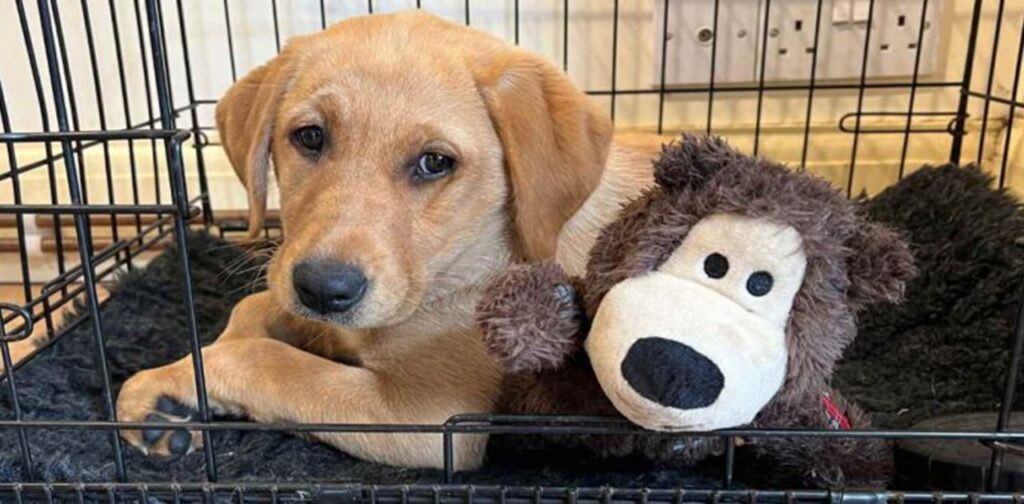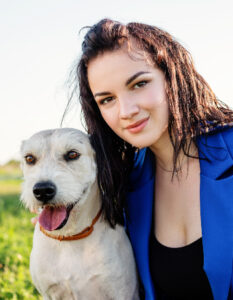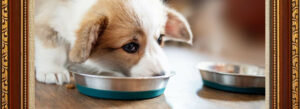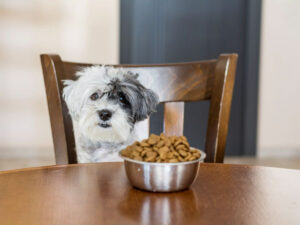Crate training may be overwhelming for the puppy in the beginning. As a result, they may create challenges during crate training.
From getting your puppy inside of the crate to establishing routines and nighttime crate training, today we are going to discuss 10 easy steps to crate training a puppy at night.
These 10 simple steps will equip you with the most efficient way to crate training your puppy.

Why is crate training important?
As much as we always want to be around our puppies, we cannot always do that and keep an eye on them. Crates serve as a secure and safe space for your puppy. It also helps in potty training through routine bathroom breaks.
Another important benefit of crate training is that it allows you to manage and prevent destructive behaviors. It will reduce separation anxiety, as the crate will work as a secure and familiar environment for your puppy.
As a result, you can travel with your lovely puppy anytime anywhere. Crates aid in training and establishing routines for feeding, sleeping, and playtime. Providing a controlled environment for positive reinforcement can help in teaching commands like “stay” and “quiet”.
What is crate training?
Before moving forward, you must know what crate training is and why it is important. Crate training is the process of training a puppy or dog to stay inside a crate voluntarily based on routines.
Normally crates are comparatively small and enclosed places, as a result, puppies or dogs may feel anxious or suffocated inside. Such situations will result in excessive barking, chewing, growling, and unwillingness to enter the crate next time.
Crate training will help to make the puppy familiar with the crate and feel secure inside. Training a dog may not be as easy as training a puppy, therefore. It is advisable to start crate training at the age of 8 weeks.
Nevertheless, it is possible to also train a dog using more focus and effort.
Why is crate training important?
As much as we always want to be around our puppies, we cannot always do that and keep an eye on them. Crates serve as a secure and safe space for your puppy. It also helps in potty training through routine bathroom breaks.
Another important benefit of crate training is that it allows you to manage and prevent destructive behaviors. It will reduce separation anxiety, as the crate will work as a secure and familiar environment for your puppy.
As a result, you can travel with your lovely puppy anytime anywhere. Crates aid in training and establishing routines for feeding, sleeping, and playtime. Providing a controlled environment for positive reinforcement can help in teaching commands like “stay” and “quiet”.
10 Easy Steps to Crate Train a Puppy at Night
In order to train your puppy to stay inside the crate during nighttime, follow the given 10 steps one by one. Soon you will be able to see a successful transition.
Step 1: Get your puppy familiar with the crate
Before starting nighttime crate training, get your puppy familiar with the crate by placing it in the house, so they can explore it by themselves and get familiar with it. Make sure to buy a well-sized crate, so it feels open and your puppy can play inside.
Keep the door open, place some of their favorite treats and toys inside, and add comfortable bedding. This way you can turn the creation into a cozy and comfortable place.
Being able to be familiar with the crate will reduce your puppies’ fear associated with the crate.
Step 2: Get your puppy inside of the crate
Start by placing the feeding bowl near the crate, for example keeping it right outside of the crate or 1 foot away from the crate. With time move the bowl closer to the entrance.
Do not rush, make sure the process is done slowly and steadily. Eventually, place the bowl inside of the crate. Reward your puppy with delicious treats once they are inside the crate.
Step 3: Closing the Crate Door
Once your puppy is comfortable inside and regularly eats inside of the crate, you should close the door for short durations during feeding. Do not leave him and do not keep the door closed after they are finished eating.
With time increase the duration and keep them busy with positive reinforcement while they are inside of the crate.
Step 4: Stay around the crate
As you may have started closing the door, the puppy can go through separation anxiety. It is important to be around and keep an eye on them.
However, you should be doing other tasks during this time, so that your puppy gets used to you doing the daily chores rather than staying with him all the time. After a while come back and reward him for being well-behaved.
Step 5: Get your puppy to follow your command
You can use both praise and treats to get your puppy to follow your commands or cues, such as “crate” or “eat”. Utter the command and lead the puppy into the crate by offering tasty treats. Once the puppy is inside the crate, feed them and praise them.
This will create a sort of positive association with the crate and the following command. With time you may witness your puppy follow the commands even without the treats.
Step 6: Introduce Routine activities involving the crate
Once your puppy is familiar and comfortable with staging inside the crate, introduce routine activities. This will help them to know in advance when to get into the crate.
Firstly, create a consistent bedtime routine by including taking your puppy outside for a bathroom break just before bedtime. This helps prevent accidents during the night.
Secondly, take your puppy on short drives while inside the crate. Gradually increase the duration. Consistently, use positive reinforcements like treats, toys, or praise.
Step 7: Nighttime Crate Training
Now that your puppy is comfortable and reassured to stay inside the crate, you can finally start the process of crate training a puppy at night. Initially place the crate in your bedroom, preferably from where your puppy can see you and smell you.
This will help them to stay calm and feel safe. With time you will be able to move the crate to your desired place. Establish a bedtime routine including a bathroom break before bedtime.
Step 8: Put Comfort Items Inside the Crate
With comfortable bedding, place your puppies’ favorite blankets and toys. Familiar scents can help them feel secure and relaxed. Be careful not to use any items that may harm the puppy.
Too small toys may not be a good idea as it poses choking hazards. Also, avoiding using items that are easily destructible or prone to breaking apart can lead to the ingestion of harmful materials.
Step 9: Quietly Praise and Reward
As your puppy is settled inside the crate at night, quietly praise them. Avoid using exited tones, rather use a soothing tone. This will help them to be reassured that everything is okay.
Avoid making a big fuss when letting them out of the crate to prevent associating crate time with excitement.
Step 10: Consistent Routine and Positive Reinforcement
Finally, ensure to regularly practice this routine. The routine will help to shape their behaviour, both at bedtime and during other times your puppy spends in the crate. Consistency is key to reinforcing positive associations with the crate for crate training a puppy at night.
Likewise, reward them consistently to train them to behave accordingly. Whether it’s following a command, settling down in the crate, or staying calm at night, reward your puppy to reinforce good behaviour.

Tips and Tricks On Crate Train a Puppy at Night
- Ensure gradual transition, do not rush the process.
- Observe and reassure your puppy accordingly.
- You can use white noise machines or calming sounds to avoid getting your puppy excited during the nighttime.
- You can also use your clothing to create a familiarity with the crate.
- Young puppies have smaller bladders, so ensure frequent bathroom breaks.
- Avoid being overly enthusiastic when letting your puppy out of the crate.
- Keep in mind that puppies are unique, and understanding their cues and preferences is crucial for effective training
Conclusion
Crate training a puppy at night can look challenging at the beginning. Therefore, you must approach this process with patience and consistency. You can utilize positive reinforcement to turn it into a rewarding experience for the puppy.
This will strengthen the bond between you and your puppy. Maintain a good balance between your puppy’s time inside and outside of the crate.
Enjoy the process and build a positive and lasting relationship between you and your canine companion.





